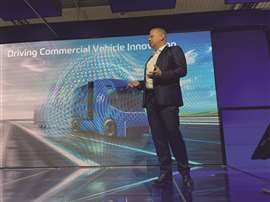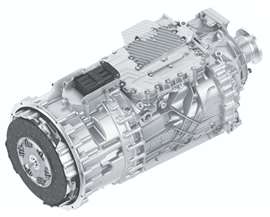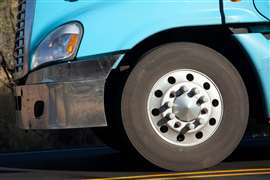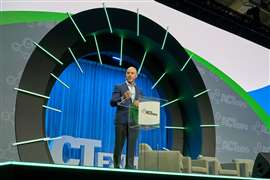Street Smarts: Trucking’s future in play at IAA
14 October 2024
Diesel-focused technologies were on display at a packed IAA Transportation Show in Germany.
The 2024 IAA Transportation Show wrapped in Hannover, Germany, on September 20. The first thing you need to know about this massive trade show is that the floor and halls of the Hannover Convention Center were absolutely jammed with attendees for its entire run.
I’ve not seen such a strong turnout for a transportation trade show since before the COVID-19 pandemic. In fact, IAA show management announced that a record 145,000 attendees were at the show. That’s up 10% from the 2022 show – and a new attendance record.
 Peter Laier, member of the ZF board of management, discusses the OE’s new hybrid truck transmission at an IAA Transportation Show press conference in Hanover, Germany. (Photo: Jack Roberts)
Peter Laier, member of the ZF board of management, discusses the OE’s new hybrid truck transmission at an IAA Transportation Show press conference in Hanover, Germany. (Photo: Jack Roberts)
That is welcome news for the North American trucking industry that has been in the doldrums the past few years. Hopefully, that trend will manifest itself over on this side of the Atlantic next year.
And there was major news at the show – all of which foreshadows major technology trends coming to North America in the near future.
Clarios Announces 24-Volt Trucking Battery
Global low-voltage battery supplier Clarios announced that it is working on several trucking-related battery initiatives. The power demands for heavy-duty trucks are evolving rapidly, according to Brian McKay, chief technology officer, Clarios.
He said that the in trucking – both on the design and use side of the equation – Clarios is seeing rising demands for more integration of electrical devices. This includes systems such as:
- heating and cooling systems to enhance driver comfort;
- auxiliary systems that are transitioning from hydraulic and air pressure to electric power;
- and more and more “by-wire” technologies like brake-by-wire and steer-by-wire systems.
Add to that the increased power demands from drivers – microwave ovens, TVs and gaming systems.
All these demands are significantly impacting the low-voltage power network in commercial vehicles and creating a demand for more onboard power.
In response, Clarios announced an agreement to develop 24-volt lithium-ion batteries for heavy-duty applications. The company is collaborating with a major European commercial truck manufacturer on the technology.
It is also exploring additional battery technologies for heavy-duty trucks, including future technologies such as a new sodium-ion battery that could replace lithium-ion batteries.
ZF Unveils Hybrid Truck Transmission
With the EPA’s Phase 3 Greenhouse Gas Emissions regulations rushing headlong at the North American trucking industry, I’ve been wondering when we’d see the return of hybrid-electric transmissions to the marketplace.
These remarkable transmissions made a brief appearance in the trucking industry about 20 years ago. They provide electric power to a truck’s drivetrain at low speeds – typically up to about 30 mph or so.
 ZF TraXon 2: The TraXon 2 hybrid transmission enables purely electric driving functions for both fully hybrid and plug-in hybrid commercial vehicles. (Photo: ZF)
ZF TraXon 2: The TraXon 2 hybrid transmission enables purely electric driving functions for both fully hybrid and plug-in hybrid commercial vehicles. (Photo: ZF)
The overwhelming bulk of NOx emissions from modern diesel engines come when the engine is cold and operating at very low speeds. The exhaust aftertreatment system is not hot enough at this stage to effectively treat NOx coming out of the stack. And this is at the same time as the engine is working overtime, burning extra fuel to get a fully loaded truck up and moving.
Hybrid transmissions help bypass these two operational issues by providing clean electric power to get the truck rolling and allowing the diesel engine to take over once the heavy lifting is done.
These advantages are not lost on ZF. Peter Laier, member of the ZF board of management, announced a brand new hybrid transmission for heavy trucks at the show. Dubbed the TraXon 2 hybrid transmission, Laier said the new transmission enables purely electric driving functions for both fully hybrid and plug-in hybrid commercial vehicles.
Laier noted that ZF’s global scale and product portfolio enabled the fast development of the new transmission. ZF’s hybrid technology was originally developed for passenger cars, he explained, and subsequently adapted to the specific requirements of commercial vehicles.
“The movement from combustion to battery-electric vehicles is going slower in some markets than others,” Laier said in a roundtable meeting with North American journalists after the press conference.
“Even in markets with regulations driving commercial vehicles toward zero-emission technologies, this transition is happening slower than initially assumed. So, there needs to be bridging technologies between diesel engine technology and zero-emission powertrains that can still help to reduce CO2 emissions. And we feel this hybrid transmission is an excellent way to achieve those goals.”
Cummins Debuts Integrated HELM Drivetrain
Cummins introduced a new integrated drivetrain focused on its HELM engine platform. And yes, a hybrid transmission is included as an option for fleets.
 Jack Roberts is a Tuscaloosa, Ala.-based independent journalist and licensed commercial driver with more than 20 years’ experience covering the North American and global trucking industries.
Jack Roberts is a Tuscaloosa, Ala.-based independent journalist and licensed commercial driver with more than 20 years’ experience covering the North American and global trucking industries.
The HELM engine platform is a fuel-agnostic series of engine versions that are derived from a common base block. Below the head gasket of each engine are largely similar components and above the head gasket there are different components for different fuel types such as advanced diesel, natural gas or zero-carbon hydrogen.
The integrated drivetrain offers fleets three options: advanced diesel, diesel-hybrid or zero-carbon hydrogen powertrains. Each drivetrain features advanced Cummins diesel and hydrogen internal combustion HELM engines, as well as front and rear axles and brakes.
Jennifer Rumsey, Cummins chair and CEO, noted that these powertrains are enhanced with aftertreatment systems and technologies from Accelera by Cummins, the zero-emissions brand of Cummins.
Rumsey emphasized that Cummins’ acquisition of Meritor, Siemens Commercial Vehicles and Jacobs Vehicle Systems in recent years means Cummins can now offer fully integrated powertrain solutions for fleets.
STAY CONNECTED



Receive the information you need when you need it through our world-leading magazines, newsletters and daily briefings.
CONNECT WITH THE TEAM







